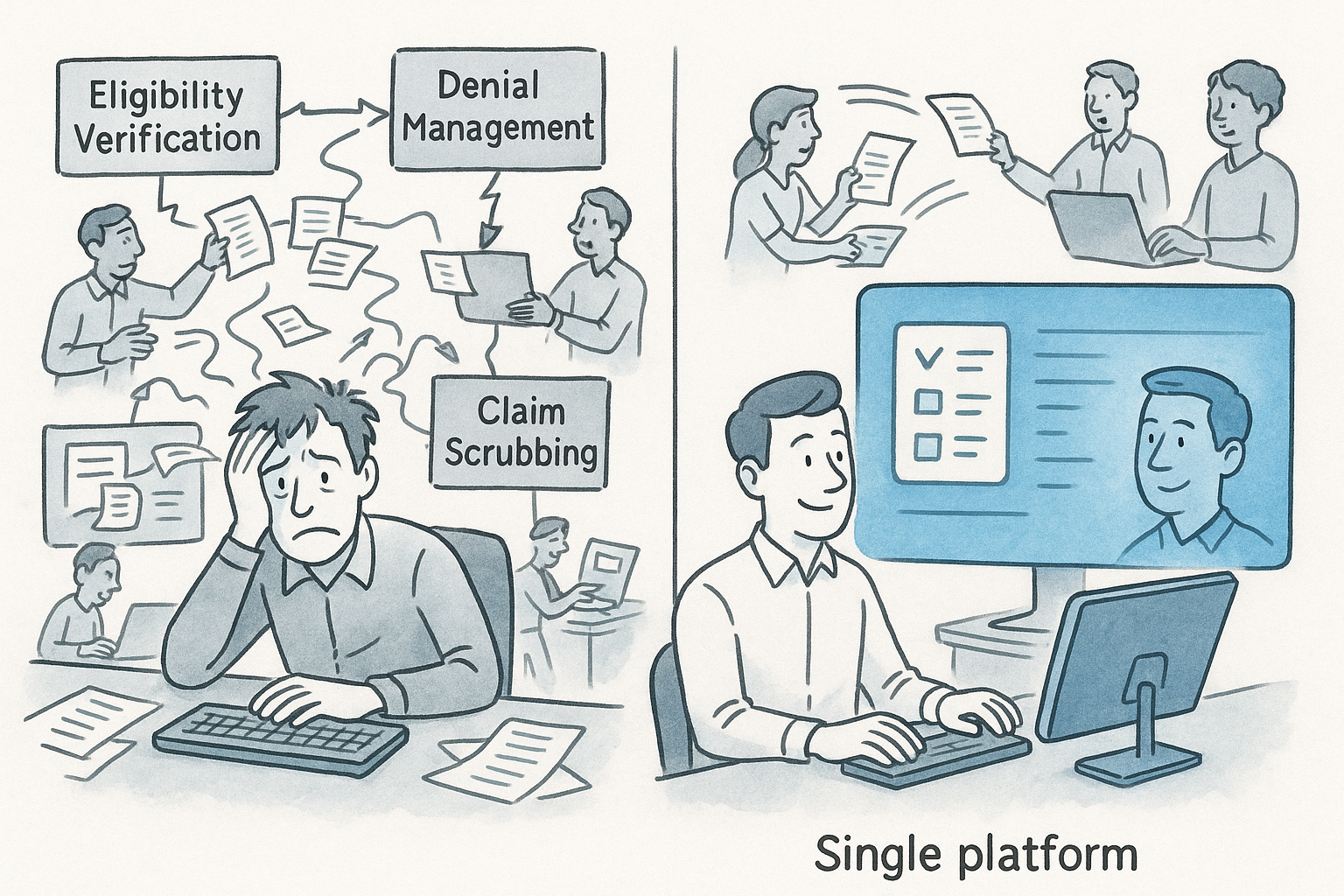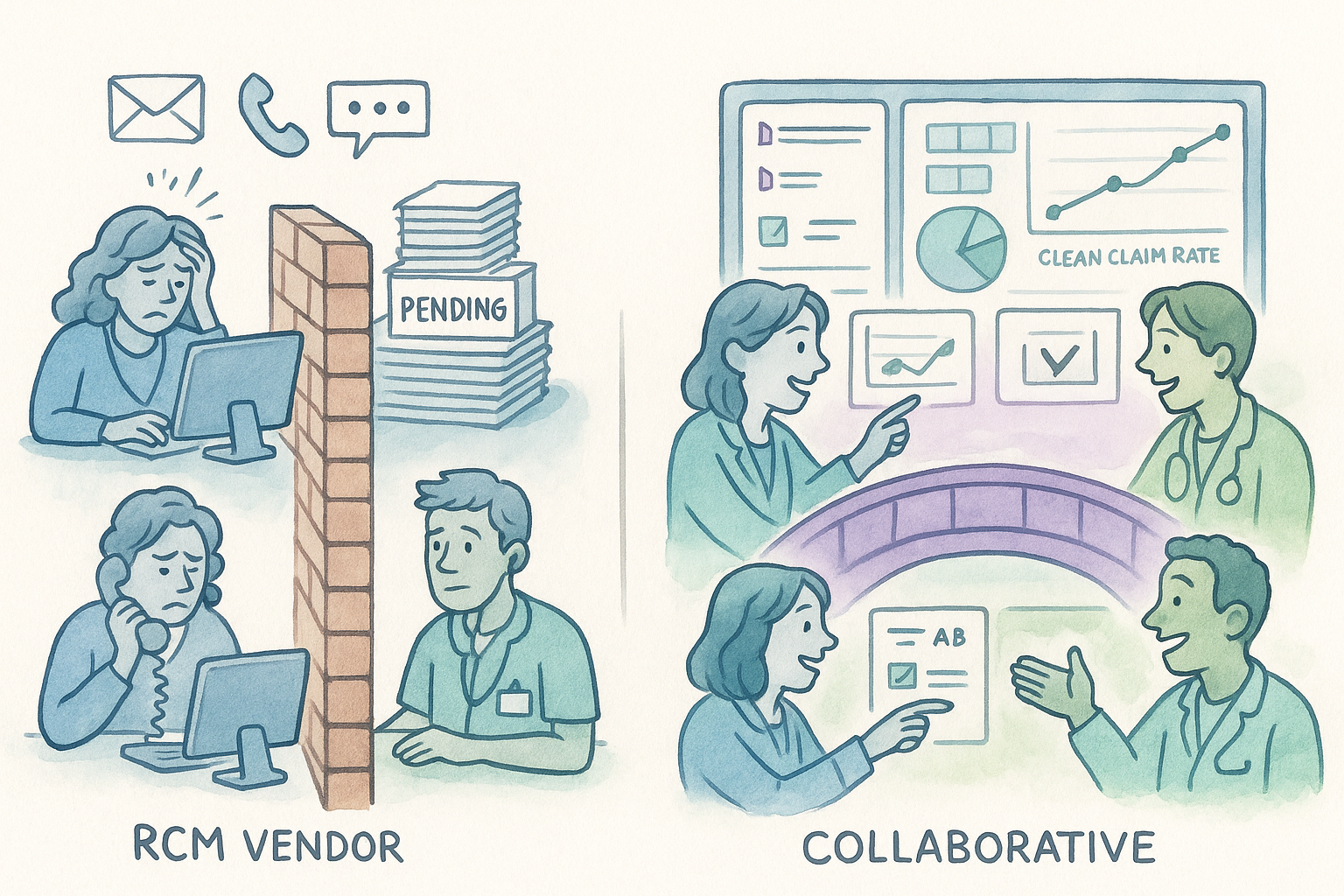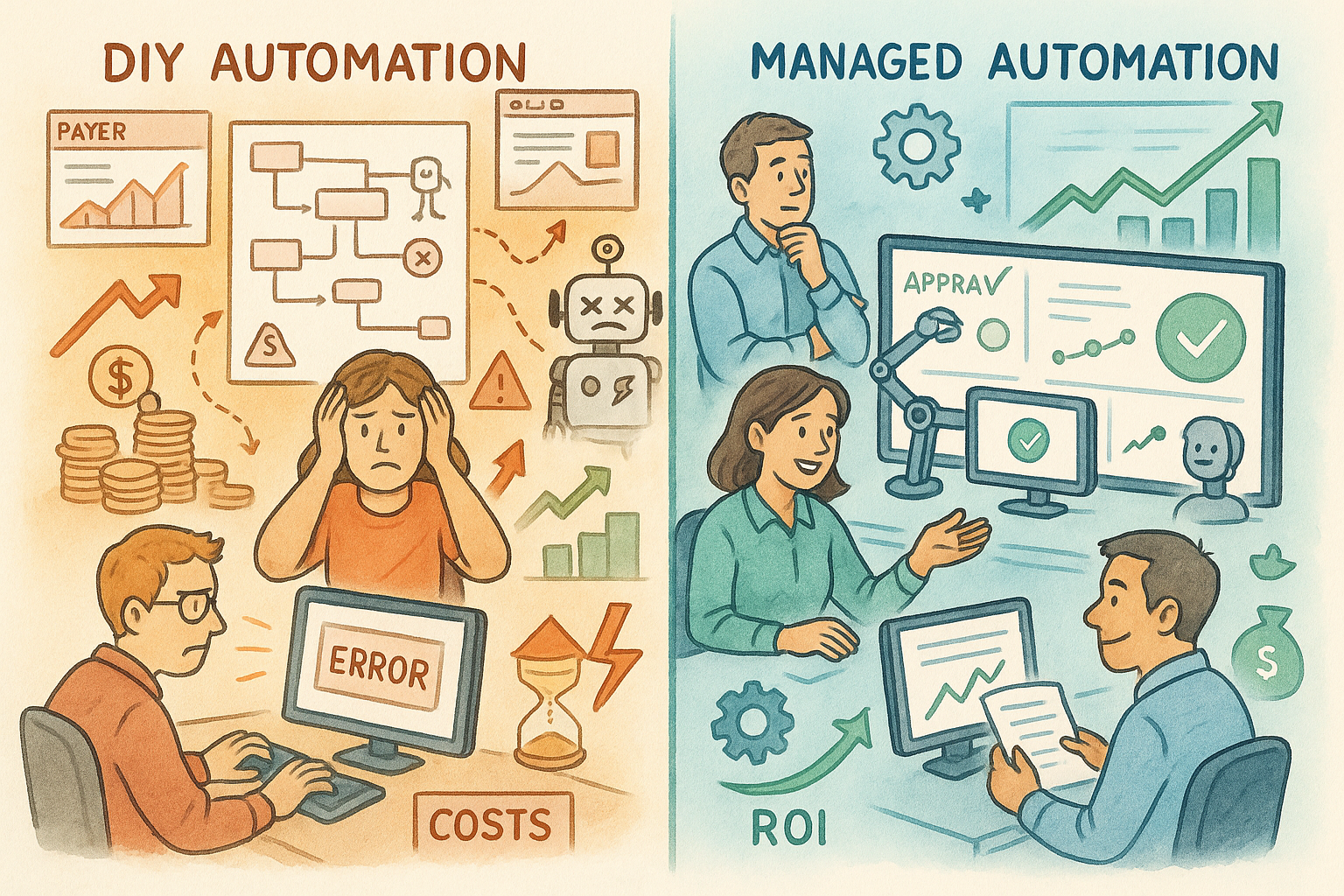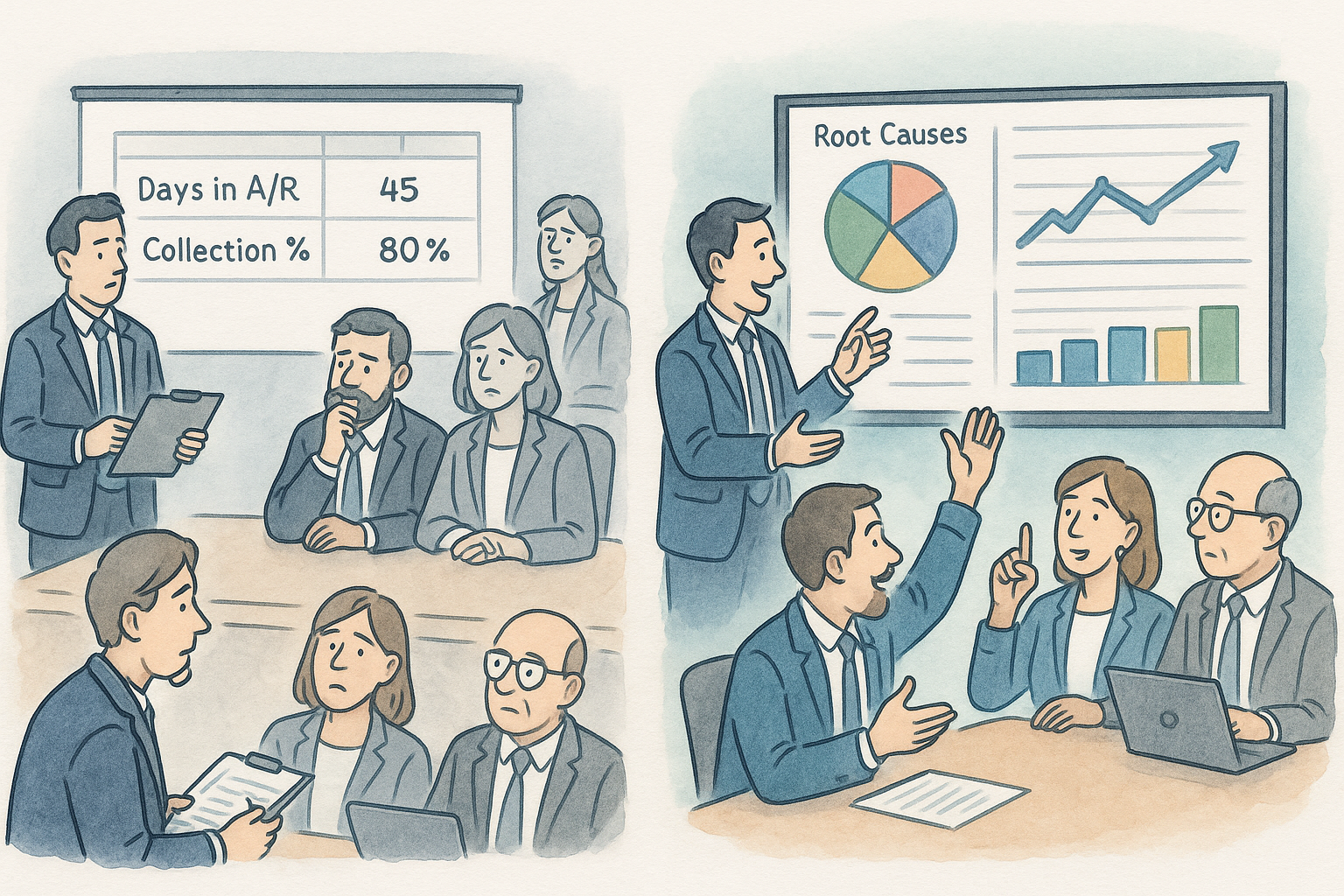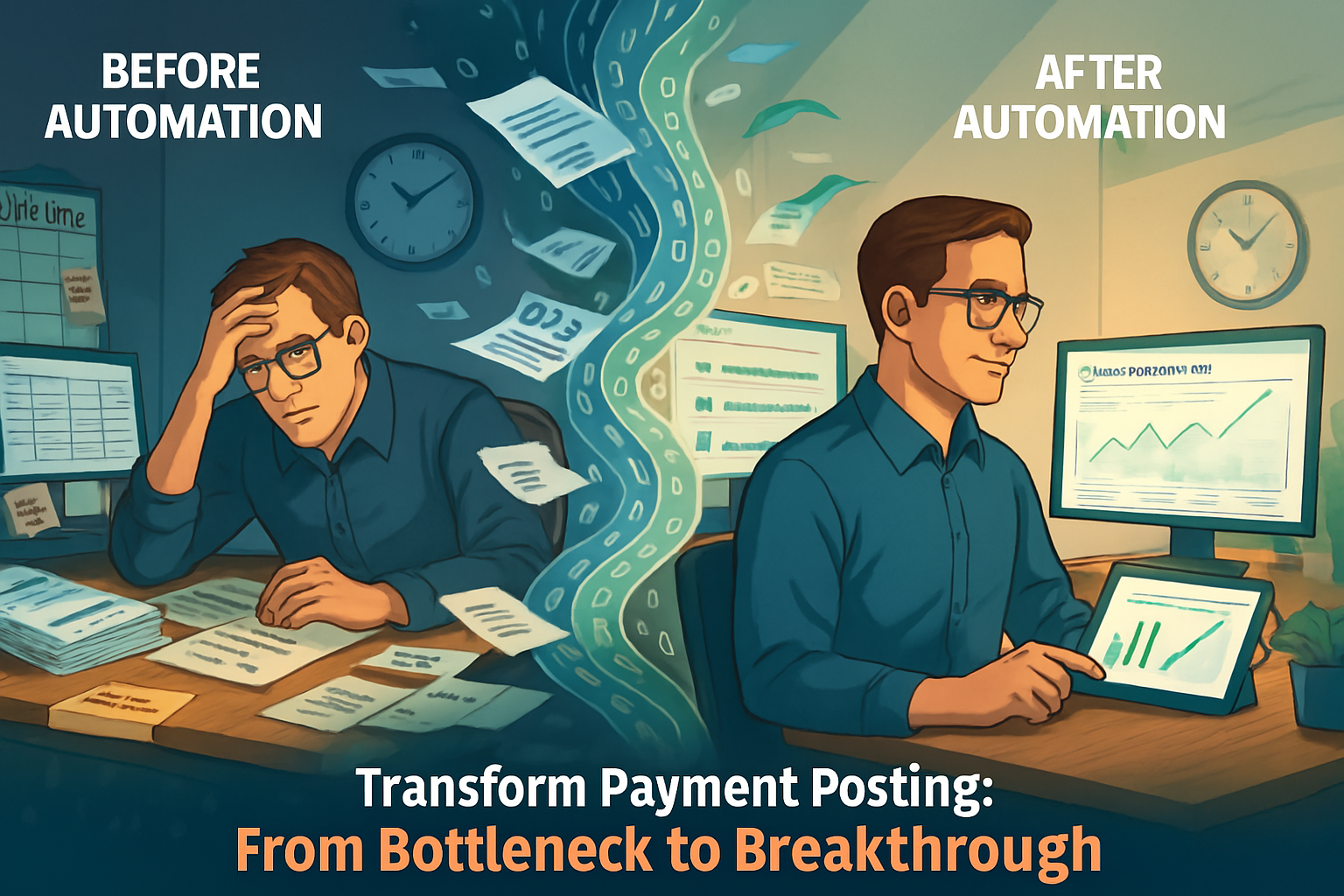In today’s healthcare revenue cycle management landscape, vendors face unprecedented challenges: shrinking margins, staffing shortages, and increasingly complex billing requirements. Many RCM vendors have responded by adopting specialized technology solutions to address specific pain points – eligibility verification tools, prior authorization automation, denial management systems, and patient payment platforms.
While these point solutions promise efficiency in their specific domains, they’ve created a new problem: fragmentation. Most RCM vendors now operate without a single source of truth, working across multiple systems, spreadsheets, and client EHRs. This fragmented approach creates substantial hidden costs that can undermine profitability and scalability.
How We Got Here: The Evolution of the RCM Tech Stack
The revenue cycle has grown increasingly complex over the past decade. The shift toward Medicare Advantage plans, intensified prior authorization requirements, sophisticated payer denial strategies, and payment integrity audits have all contributed to this complexity.
As each new challenge emerged, technology vendors developed specialized solutions – and RCM companies understandably adopted them to stay competitive. The result? A technological patchwork where:
- Front-end eligibility and benefits verification happens in one system
- Prior authorization processing occurs in another
- Claim scrubbing and submission use different platforms
- Denial management and appeals have their own specialized tools
- Patient payment and collections operate in yet another environment
What began as a series of tactical decisions to solve immediate problems has resulted in a fragmented technology ecosystem that introduces significant operational friction.
Quantifying the Hidden Costs of Fragmentation
The true cost of operating with disconnected point solutions goes far beyond the obvious software expenses. Here are the hidden costs that drain your profitability:
1. Staff Training and Proficiency
Each system requires training, and proficiency isn’t transferable. Staff must learn multiple interfaces, workflows, and quirks across systems. This:
- Extends onboarding time for new hires from weeks to months
- Reduces overall staff productivity due to partial mastery of multiple systems
- Creates dependency on “system experts” who become single points of failure
- Makes cross-training nearly impossible, creating staffing vulnerabilities
One mid-sized RCM vendor calculated that their employees needed proficiency in seven different systems to handle the complete revenue cycle. The training cost alone exceeded $12,000 per new employee – before they generated any revenue.
2. Context Switching Penalties
When staff must toggle between systems to complete related tasks, they incur what productivity researchers call “context switching penalties.” Studies show that employees lose 20-40% of their productive time when frequently switching between different tools and interfaces.
For example, when working a denial:
- The staff member checks the denial code in the claim system
- Switches to the eligibility system to verify coverage
- Opens the EHR to review clinical documentation
- Consults another system for payer-specific requirements
- Drafts the appeal in yet another platform
Each transition requires refocusing and reorientation. Over the course of a day, these transitions significantly reduce throughput.
3. The Integration Tax
Maintaining connections between systems that weren’t designed to work together creates ongoing costs and compliance risks:
- Custom integration development and maintenance
- Troubleshooting data synchronization issues
- Managing security vulnerabilities at integration points
- Debugging errors when upstream systems change
One RCM vendor we worked with had dedicated 20% of their IT team’s capacity solely to maintaining integrations between their point solutions – resources that could have been directed toward revenue-generating initiatives.
4. Data Integrity Challenges
When information passes between systems, data quality inevitably suffers. Fields get truncated, formats change, and updates in one system don’t propagate to others. The result?
- Staff spending time reconciling conflicting information
- Decisions made based on outdated or incomplete data
- Compliance risks from inconsistent documentation
- Eroding client trust when information doesn’t match
5. Reporting and Analytics Limitations
Perhaps the most significant hidden cost is the inability to gain unified insights across the revenue cycle. With data spread across multiple systems, RCM vendors struggle to:
- Identify root causes that span different parts of the revenue cycle
- Track performance metrics consistently across clients and processes
- Provide clients with comprehensive views of their revenue performance
- Make data-driven decisions about resource allocation and process improvement
Many vendors resort to labor-intensive manual reporting processes, pulling data from multiple systems into spreadsheets for analysis – creating additional costs and introducing errors.
The Financial Impact: A Case Study
To illustrate the combined impact of these hidden costs, consider this anonymized case study of an RCM vendor serving 15 ambulatory surgery centers:
Before Technology Consolidation:
- 6 separate technology systems
- 32 staff members
- Average cost per claim: $12.58
- Days in A/R: 42
- Staff turnover rate: 28% annually
After Consolidating to an Integrated Platform:
- 1 central platform + client EHRs
- 26 staff members (19% reduction)
- Average cost per claim: $9.87 (22% reduction)
- Days in A/R: 34 (19% reduction)
- Staff turnover rate: 17% annually
The vendor achieved these improvements not through automation alone, but primarily by eliminating the friction created by their fragmented technology approach. By creating a single source of truth and streamlining workflows across the revenue cycle, they improved both efficiency and effectiveness.
The Path Forward: Building an Integrated Approach
Transitioning from a fragmented technology ecosystem to an integrated platform requires careful planning, but offers substantial returns. Consider these steps:
- Conduct a system audit: Document all systems, their purposes, and integration points
- Calculate the true cost: Quantify spending on licenses, integration, training, and support
- Map cross-system workflows: Identify where processes span multiple systems
- Prioritize consolidation opportunities: Focus on areas with highest friction first
- Develop a phased transition plan: Move methodically to minimize disruption
The most successful transitions maintain parallel operations temporarily, allowing staff to adapt while ensuring continuity for clients.
Conclusion: The Competitive Advantage of Integration
In a market with compressed margins and rising client expectations, RCM vendors can no longer afford the hidden costs of fragmented technology. Those who consolidate their tech stack around a central platform gain significant advantages:
- Lower operational costs through reduced administrative overhead
- Faster onboarding and greater staff flexibility
- Improved data quality and compliance
- Enhanced client insights and reporting capabilities
- Better scalability as the business grows
As one of our clients noted: “We used to compete on price and relationships. Now we compete on insights and results – and our integrated platform makes that possible.”
In today’s challenging healthcare environment, eliminating the hidden costs of fragmentation isn’t just about efficiency – it’s about creating sustainable competitive advantage.
Lockbox helps RCM vendors reduce costs and improve client satisfaction with our all-in-one platform for workflow optimization, analytics, and managed automation. Learn how our integrated approach can transform your revenue cycle operations at www.lockboxai.com.
